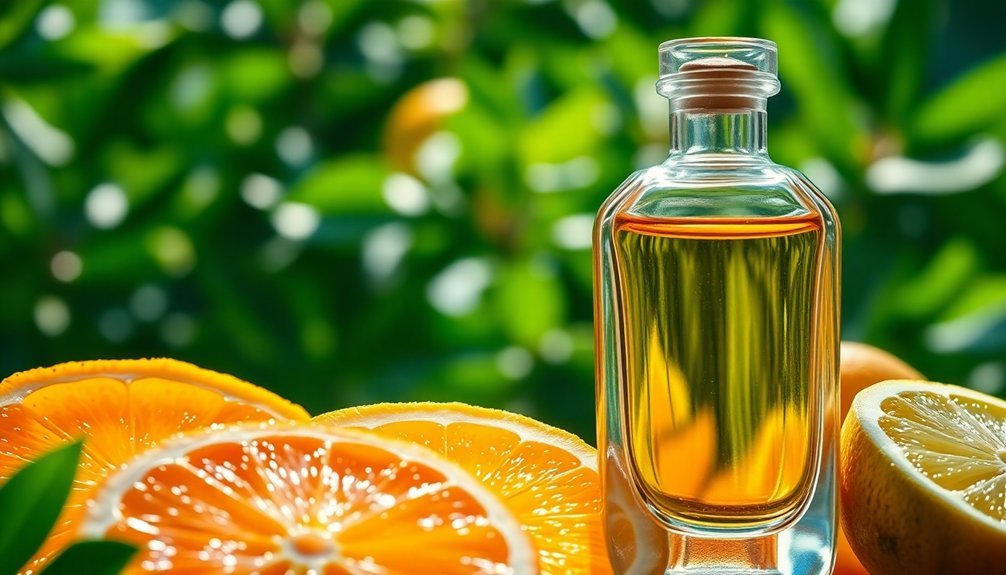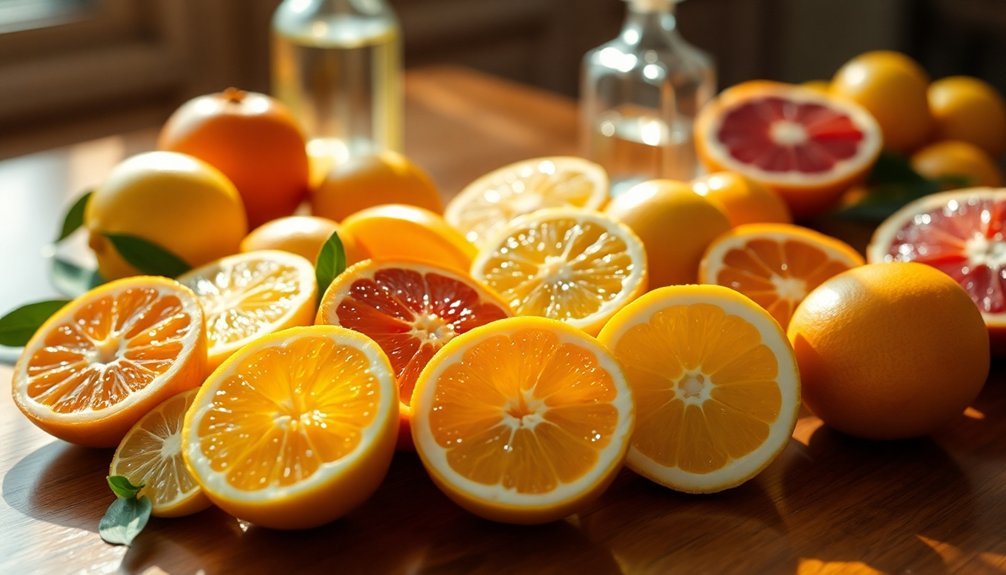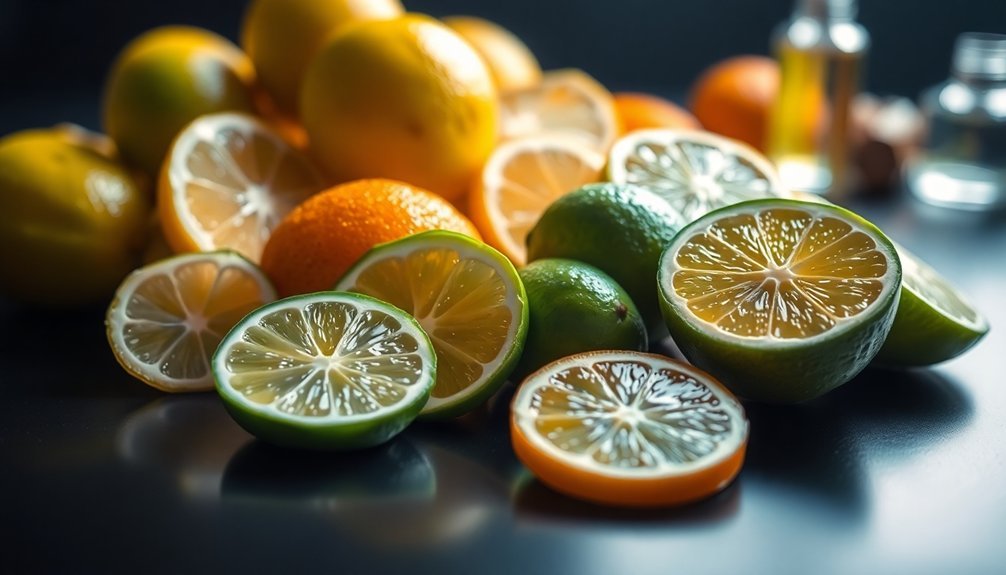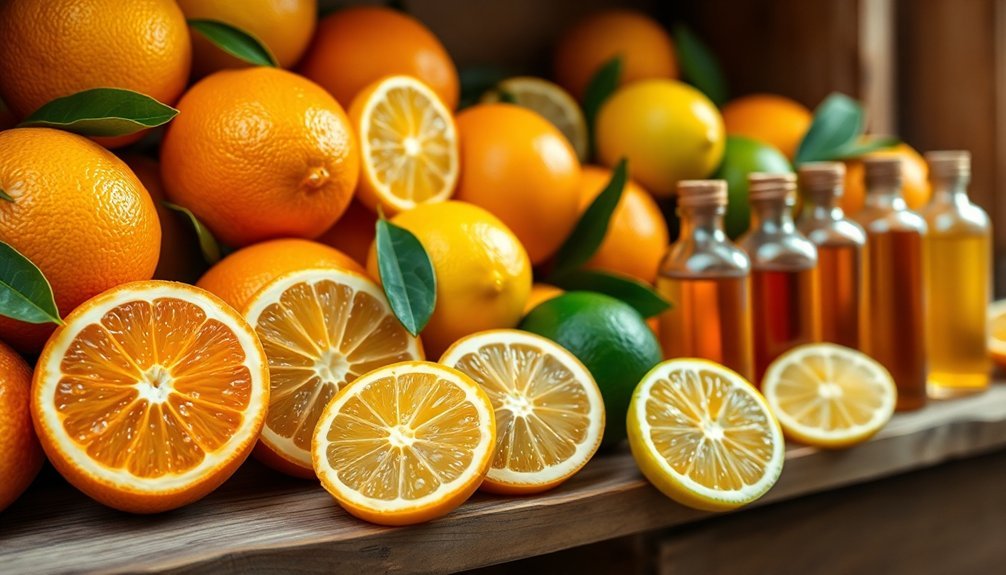To blend bright citrus top notes for your perfect perfume, start with a primary citrus oil like bergamot or lemon as your foundation. You'll want to layer complementary citrus notes, such as grapefruit or mandarin, to build complexity while avoiding overwhelming the senses. Add depth by incorporating middle notes like lemongrass or lavender, then anchor with base notes such as vanilla or sandalwood. Understanding the unique personality of each citrus element will reveal endless aromatic possibilities.
The Magic of Citrus in Perfumery

When you first encounter a citrus-based perfume, you'll immediately notice its revitalizing and invigorating qualities that awaken the senses. Each citrus fruit brings a distinct personality – bergamot's headiness, grapefruit's aromatic sweetness, and lemon's energetic zing create that perfect initial impression. Essential oils from peels give citrus fragrances their signature bright character.
You'll find citrus notes aren't just about fragrance; they're therapeutic powerhouses. They can lift your mood, ease stress, and boost mental clarity. When you're feeling anxious or fatigued, these bright scents can help restore your balance and energy.
What makes citrus truly magical is its versatility. You'll discover how beautifully it blends with florals, adding sparkle to rose or jasmine.
When combined with woody notes like oud or oriental spices, you'll experience a sophisticated harmony that's both fresh and deep.
Understanding Essential Citrus Oils
As you explore essential citrus oils, you'll find that cold pressing stands as the primary extraction method, where fruit peels are carefully ground to release their precious aromatic compounds.
Through filtering and centrifuging, you'll get pure oils that maintain their natural fragrances.
You'll discover that each citrus oil offers unique characteristics: lime delivers potency, grapefruit radiates brightness, bergamot provides floral complexity, and mandarin brings sweet calmness. Their light, summery aromas work beautifully even during winter months.
These oils serve as uplifting top notes in perfumery, perfect for brightening deeper aromas.
Rich in limonoids and flavonoids, citrus oils pack powerful antioxidant and antibacterial properties.
You can blend them into various applications, from aromatherapy and skincare to household cleaning products.
Their versatility shines in both professional and casual settings, making them essential components in your perfume-making journey.
Crafting Your Signature Citrus Blend

The art of creating your signature citrus blend begins with understanding how to layer different aromatic elements. Start by selecting your base citrus note – whether it's bright bergamot, zesty lemon, or sweet orange – and apply it to your pulse points.
You'll want to add complementary citrus or green notes to build complexity. Try pairing lemon with grapefruit or adding fresh mint to create depth. Using moisturized skin application will help your fragrance last significantly longer.
Don't forget to incorporate middle notes like lemongrass or lavender, which help your fragrance last longer.
For the final touch, anchor your blend with base notes such as vanilla or sandalwood. These deeper elements provide staying power and ground your citrus creation.
Let your blend rest for a few days, allowing the components to meld together. You can adjust the ratios until you've achieved your perfect signature scent.
Balancing Sharp and Sweet Notes
Creating harmonious fragrances requires mastering the delicate interplay between sharp citrus notes and sweet elements.
You'll find citrus pairs beautifully with floral notes, adding a fresh edge to jasmine's sweetness and brightening classic rose scents. When working with gourmand elements, citrus cuts through rich caramel and chocolate notes, preventing them from becoming overwhelming.
For a more complex blend, try combining citrus with woody notes like cedarwood or sandalwood. These combinations create an earthy, forest-like atmosphere while maintaining brightness.
You can also anchor your citrus notes with musk and amber, which provide lasting power and depth. The musk smooths out citrus's sharp edges, while amber adds a warm sweetness that complements the zesty top notes perfectly.
Seasonal Citrus Combinations

While citrus notes remain versatile year-round, each season calls for distinct combinations that enhance their natural vibrancy.
In winter, you'll find mandarin orange paired with cedar and warming spices like cinnamon, helping to brighten those dark days.
Spring welcomes invigorating blends of lemon and bergamot, often combined with delicate florals like jasmine or rose.
Summer's heat is perfectly matched with lime and coconut for a tropical feel, while orange-vanilla combinations create an uplifting atmosphere.
You can also incorporate bergamot with lavender for a balanced summer scent.
As autumn approaches, shift your citrus fragrances by combining orange with amber and spices, or try grapefruit with earthy, woody notes.
Don't forget that mandarin orange works beautifully with cedar and cinnamon for a cozy fall atmosphere.
Enhancing Citrus With Complementary Scents
To elevate your citrus fragrances, you'll discover endless possibilities by pairing them with complementary scents across four main categories: floral, herbal, woody, and sweet notes.
For a romantic touch, try combining bergamot with lavender or orange blossom with jasmine.
If you're seeking an invigorating blend, pair grapefruit with rosemary or lemon with fresh mint.
When you want a more grounded, sophisticated scent, mix orange blossom with patchouli or grapefruit with cedarwood. These woody combinations create depth and staying power.
For a sweeter profile, you can't go wrong with classic pairings like orange and vanilla or lime and coconut.
These combinations offer a delightful twist that's both uplifting and memorable. Each pairing creates its own unique character while maintaining the bright, energetic qualities of citrus.
Common Mistakes to Avoid When Blending

When blending perfumes, you'll want to avoid overloading your mixture with citrus notes, as too much can overwhelm the senses and create an unbalanced composition.
You must carefully balance top, middle, and base notes to achieve harmony, ensuring no single element dominates the blend.
While citrus scents can brighten a fragrance, they shouldn't clash with complementary ingredients, so test small batches before committing to larger quantities.
Too Much Citrus Volume
Although citrus notes can add a bright, invigorating element to perfumes, using too much can derail your entire fragrance blend. You'll want to avoid overwhelming the heart and base notes, which can result in a one-dimensional scent lacking depth and complexity.
| Issue | Solution |
|---|---|
| Short Longevity | Balance citrus with lasting base notes |
| Seasonal Mismatch | Reduce citrus volume in winter |
| Sensitivity Risk | Test small amounts first |
When you're working with citrus, remember that less is often more. Too much citrus won't just fade quickly – it can trigger headaches and sensitivities in some people. Make sure you're giving each layer proper drying time and considering the overall harmony of your blend. Don't let your enthusiasm for bright, zesty notes overshadow the importance of a well-balanced fragrance.
Improper Note Balancing
Creating a perfectly balanced fragrance requires understanding the delicate interplay between top, heart, and base notes.
When you're layering scents, the order and timing of application make all the difference in achieving your desired fragrance profile. You'll want to start with lighter scents before moving to stronger ones, allowing each layer to dry completely.
- Apply perfume oils first due to their higher concentration, then follow with traditional eau de parfum.
- Let each fragrance develop fully before adding the next layer to prevent muddling.
- Avoid combining more than three fragrances to maintain a clear, balanced composition.
- Consider your skin chemistry when selecting scents, as fragrances react differently based on your body's unique pH levels and temperature.
Remember that applying heavier base notes first can overwhelm lighter top notes, resulting in an unbalanced blend.
Clashing Ingredient Combinations
Beyond mastering note balance, understanding which ingredients clash can make or break your fragrance blend. You'll want to avoid combining strong citrus with heavy florals, as they often create an unbalanced, conflicting scent. Similarly, woody notes typically don't pair well with intense fruity elements, while floral and strong herbal combinations can produce jarring results.
| Fragrance Type | Avoid Mixing With | Result |
|---|---|---|
| Citrus | Heavy Florals | Unbalanced scent |
| Woody | Strong Fruit | Incompatible blend |
| Floral | Strong Herbs | Jarring clash |
| Oriental | Fresh Notes | Disrupted aroma |
| Complex Oils | Other Complex Oils | Confused scent |
Before mixing, consider how each fragrance family interacts. Test your combinations over time, as some notes may evolve poorly together. Remember to account for your skin type, as it can affect how fragrances interact and develop.
Storage and Shelf Life of Citrus Blends

Since citrus-based perfumes are particularly delicate, proper storage is essential for maintaining their vibrant character.
You'll want to protect these fragrances from light, heat, and moisture to prevent rapid degradation of their bright top notes. Store your citrus blends in their original bottles with tight-fitting caps to minimize oxidation and preserve their freshness.
- Keep your citrus perfumes in a cool, dark cabinet away from bathroom humidity
- Never leave bottles uncapped or exposed to direct sunlight
- Store fragrances in their original packaging, which provides ideal protection
- Check regularly for changes in color or scent that indicate degradation
Remember that citrus notes are among the most fragile ingredients in perfumery.
With proper storage, you can extend your fragrance's life beyond two years, but poor conditions might reduce it to just six months.
Testing and Adjusting Your Creation
Now that you've mastered proper storage techniques, it's time to evaluate your perfume creation. Start by dipping labeled blotters into your fragrance and allow them to dry for a few seconds.
Hold each blotter an inch from your nose and take gentle whiffs to assess the top notes, which typically last 5-15 minutes.
Next, test your perfume on your skin's pulse points – wrists, neck base, and inner elbows. Don't rub the fragrance; let it develop naturally for at least an hour.
Take notes on how the scent evolves and compare it to your intended blend.
To maintain accuracy, limit yourself to testing 3-4 scents before taking a break. Clear your nose by exhaling into your bent elbow, and verify you're testing in an area free from competing aromas.
Frequently Asked Questions
Can Citrus Notes Trigger Allergic Reactions When Applied to Skin?
Yes, citrus notes can trigger allergic reactions on your skin, causing symptoms like redness, itching, and hives. You'll want to be careful since even contact dermatitis and severe reactions are possible.
How Do Synthetic Citrus Notes Compare to Natural Essential Oils?
You'll find synthetic citrus notes offer better stability and consistency than natural oils, though they lack the complex, authentic scent profile. They're gentler on your skin but may contain potentially harmful synthetic ingredients.
Do Citrus-Based Perfumes Attract Insects During Outdoor Wear?
You'll find that citrus-based perfumes actually help repel insects rather than attract them. They contain compounds like Citral that mosquitoes and other biting insects dislike, making them a good choice for outdoor wear.
Which Citrus Notes Last Longest in Extreme Weather Conditions?
You'll find bergamot and bitter orange last longest in extreme weather, as they're more stable citrus notes. They'll perform better than lemon or lime, especially when combined with fixative ingredients.
Can Citrus Notes Interfere With Medications When Worn as Perfume?
You shouldn't worry about citrus notes in perfumes interfering with medications. While grapefruit can affect drugs when eaten, topical application through perfume contains minimal amounts that aren't likely to cause interactions.
In Summary
You've learned the essentials of blending bright citrus notes to create your perfect perfume. Now it's time to experiment with confidence, knowing how to balance sharp and sweet elements while avoiding common pitfalls. Remember to store your creations properly and test them thoroughly. Don't be afraid to adjust your formulas until you've achieved that signature scent that's uniquely yours.
References
- https://www.australiannativeproducts.com.au/blogs/news/citrus-notes-in-perfume-a-fresh-twist-on-classic-fragrances
- https://dokumen.pub/smellosophy-what-the-nose-tells-the-mind-9780674245426.html
- https://us.clivechristian.com/blogs/olfactive-family/citrus-fragrance-family
- https://sinhp.github.io/files/posts/2018/little-brown-book.pdf
- https://basenotes.com/community/threads/formula-top-notes-citrus-middle-fresh-rose-base-vetiver.445003/
- https://anthonymarmin.com/the-perfume-blog/citrus-in-perfumery
- https://creedboutique.com/blogs/creed-journal/ingredient-spotlight-citrus
- https://www.czechandspeake.com/fragrance/journal-posts/citrus-perfume/
- https://happywax.com/blogs/from-the-blog/scent-spotlight-citrus
- https://www.nisarabeauty.com/blogs/blogs/your-ultimate-guide-to-citrus-based-perfumes





Leave a Reply